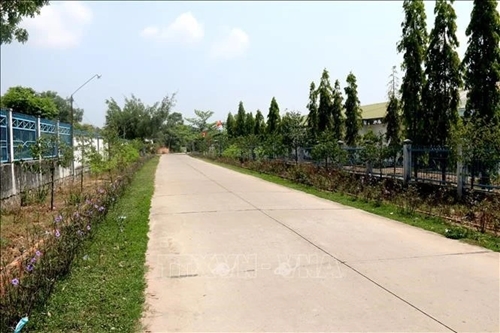These efforts have also contributed to promoting the development of agriculture and rural areas while leveraging the potential and advantages of each area in the province.
    |
 |
|
A rural road in Duc Linh district, Binh Thuan province |
Nguyen Minh Tan, head of the provincial board for ethnic affairs, said many programs and projects for promoting socio-economic development in ethnic minority areas have continued to receive investment from many funding sources, with a total budget of over VND 600 billion (over USD 23.74 million). As a result, infrastructure facilities in mountainous districts have been developed in a timely manner, aligning with the strategy for modernizing agriculture and rural areas in ethnic minority regions.
Currently, 100% of the communes in ethnic minority areas have roads reaching their centers. The national grid, postal and telecommunications infrastructure cover all the localities.
The province has invested in commercial and service infrastructure in ethnic minority-inhabited communities, while the healthcare network continues to be improved, basically meeting the primary healthcare demand of locals. Communal health stations are staffed with doctors, as well as midwives or obstetric and pediatric professionals.
By the end of 2023, seven out of 17 communes with ethnic minorities in Binh Thuan had been recognized as new-style rural areas. The average annual per capita income in ethnic minority and mountainous areas reached VND 46.8 million. The household poverty rate in these areas decreased to 7.73% by early 2024 from 10.04% at the beginning of 2019.
The implementation of social welfare, economic development, and poverty reduction policies have been widely supported by local communities, laying a foundation for strengthening the great national unity bloc and maintaining political security as well as social order and safety.
Binh Thuan aims to increase the average per capita income in ethnic minority communities by 45–50% and bring the household poverty rate down by 1.5–2% per year. It targets 100% of communal health stations and schools built permanently, 99.5% of local households accessing the national grid, and 98% of households using safe water.
To that end, Tan said that authorities will focus on optimizing land use and promoting crop and livestock farming based on each area's advantages to raise income for people and secure sustainable poverty reduction.
Attention will also be paid to attracting investment to key products; firmly maintaining political security and social order; comprehensively developing education – training, health care and culture; preserving and bringing into play cultural identities of ethnic minorities; and investing in cultural infrastructure to better the quality of people's material and spiritual lives, he went on.
Source: VNA